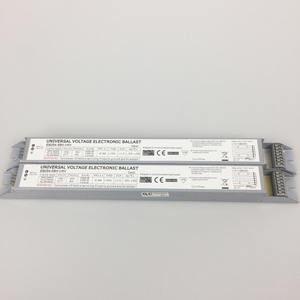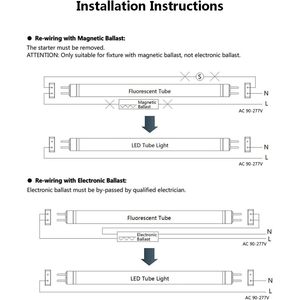(127 products available)
















































































































































































A T8 T12 ballast is a small electrical device used to power fluorescent tubes. It regulates the current to the tube to ensure it doesn't draw too much electricity, which could damage the tube or cause it to overheat. The ballast is a necessary part of the circuit that enables the fluorescent tube to light up when the switch is turned on.
The T12 and T8 refer to the size of the tube. The T12 tube is 1.5 inches in diameter, while the T8 is 1 inch in diameter. The letter ""T"" indicates tubular. These tubes are commonly used in commercial and residential lighting. The ballast comes in two types: magnetic and electronic.
The T8 and T12 ballasts can be either magnetic or electronic. The T12 ballast is compatible with the older fluorescent tubes and requires a larger space to install. On the other hand, the T8 ballast is used with newer tubes and has a more compact design. It is also more energy efficient and provides better quality lighting than the T12 ballast.
The T12 and T8 ballasts serve as electrical transformers with different functions and features. Here are their features and functions:
Starting and stabilizing the lamp
The ballast is responsible for starting the fluorescent lamps and stabilizing them. It provides the lamp with a high starting voltage that is required to ignite the gas and vapor within the tube. Once the tube is started, the ballast limits the current to prevent overheating and over-exceeding the tube.
Current control
The T8 and T12 ballast controls the electric current flowing through the fluorescent lamp. When the tube is lit, it requires a specific amount of current to continue operating. The ballast ensures that the current is maintained at an optimal level. This prevents any damage to the tube and ensures stable operation.
Voltage drop
The T8 and T12 ballast drops the voltage across the lamp. Once the gas is ignited, the voltage across the lamp is dropped by the ballast to a certain extent. Dropping the voltage helps stabilize the current flow through the tube and avoid any damage to the lamp.
Electromagnetic ballast
Electromagnetic T8 and T12 ballasts are inductive components that are used to start and limit the fluorescent tube's current. They are made with copper wire, steel core, and aluminum foil capacitors. These products are heavier, less energy-efficient, and larger than their electronic counterparts.
Electronic ballasts
Electronic ballasts are solid-state devices that control and limit the current flowing through the fluorescent tube. They are made with semiconductors, capacitors, and resistors. Their operation is more efficient than electromagnetic ballasts, and they are usually lighter and smaller. Also, they are more efficient and provide better flicker-free lighting.
Fluorescent tube light installations in commercial and residential spaces commonly use T8 and T12 ballasts. Here are some scenarios where they can be used:
Office Lighting
Ballasts for T8 and T12 lamps are often used in office lighting setups. They provide a steady and reliable light source. Also, they improve employees' focus and productivity. The soft and ambient lighting reduces glare. This makes it easy for employees to work on computers or other office tasks.
Retail Stores
T12 and T8 ballasts are important in retail lighting. They make the store attractive to customers by illuminating displays and merchandise. The lights are also customizable. This creates different moods and atmospheres for various types of stores. For example, clothing shops and electronic stores.
Healthcare Facilities
Lighting in hospitals, clinics, and health centers uses T8 and T12 ballasts. The lights provide a clean and bright environment for patients. They also promote healing and relaxation. This is especially in hospitals and healthcare facilities areas like waiting rooms and lounges.
Educational Institutions
T8 and T12 ballasts are used in schools, colleges, and universities. They provide lighting for classrooms, libraries, and administrative areas. The lights create a conducive learning environment. They help students and teachers to concentrate and work efficiently.
Industrial and Manufacturing Settings
T8 and T12 ballasts are used in industrial lighting systems. They provide bright and uniform lighting. This improves visibility in factories, warehouses, and production areas. The reliable lighting makes it safe for workers to carry out tasks. This is more so for those using heavy machinery and performing intricate operations.
Hospitality Industry
Ballasts for T8 and T12 tubes are used in hotels, restaurants, and entertainment places. They offer warm and inviting lighting. This enhances the ambience and mood. For example, in dining areas, reception lobbies, and conference rooms. The lighting improves the visual appeal and dining experience in restaurants.
Parking Garages and Exterior Spaces
T8 and T12 ballasts are useful in lighting for parking lots, garages, and outdoor areas. They provide bright and consistent illumination. This improves safety and security. The lights are reliable and efficient. This helps to light pathways, entry points, and parking spaces.
When choosing T8 and T12 ballast for operating fluorescent lights, there are several factors buyers must consider. They include:
Compatibility
Business owners should ensure that the T8 or T12 ballast they purchase is compatible with the lamp and fixture they intend to use. The T12 ballast cannot be used with T8 tubes and vice versa. Also, the magnetic ballast is only compatible with non-electronic starters, while the electronic ballast is suitable for T8 lamps.
Wattage Rating
The wattage rating of the ballast determines the amount of power it uses. Therefore, business owners should purchase a T8 or T12 ballast with wattage rating compatible with the fluorescent tubes they intend to use. Using a lower-rated ballast may lead to underpowering the lamp, while an over-rated ballast may damage the tubes.
Ballast Type
Fluorescent ballast comes in two types: magnetic and electronic ballasts. The magnetic ballast is a traditional model that operates quietly, while the electronic ballast is advanced, energy efficient, and provides better light output. Business owners should select a ballast type based on their clients' needs and preferences.
Starting Characteristics
Business owners should consider the starting characteristics of T8 and T12 ballasts when buying in bulk. For example, electronic ballasts have a rapid and reliable start-up in cold and ambient temperatures. On the other hand, magnetic ballasts have a simple start-up method but may fail to start in cold temperatures.
Maintenance
Buyers should consider the maintenance level required for both T8 and T12 ballasts. The magnetic ballasts may require more maintenance due to their components, such as capacitors and coils. At the same time, the electronic ballasts have more advanced technology and components that may require specialized maintenance.
Environmental Impact
Buyers should consider the environmental impact of both T8 and T12 ballasts. Generally, T8 ballasts are more environmentally friendly than the T12 ballasts due to their advanced technology. Business owners who intend to serve eco-friendly customers should buy T8 ballasts.
Q1: Can T8 bulbs work without a ballast?
A1: T8 bulbs cannot work without a ballast. The ballast regulates the current flowing through the bulb. It is an essential part of the fluorescent lighting system.
Q2: Are T12 bulbs being phased out?
A2: T12 bulbs are being phased out by the federal government. The government is currently phasing out magnetic ballasts. As a result, most manufacturers have stopped producing T12 bulbs and ballasts. The T12 bulbs will be obsolete in the coming years.
Q3: What are the advantages of T8 over T12?
A3: The T8 fluorescent tube has many advantages over the T12. First, the T8 tube is more energy-efficient. It consumes less energy than the T12. Second, the T8 tube has a longer lifespan than T12. It lasts for many hours. Finally, the T8 tube emits a brighter light than T12.
Q4: What does a ballast do?
A4: A ballast is an electrical device. It is used to control the current flow in a fluorescent tube. The ballast helps to regulate, stabilize, and limit the fluorescent tube.
Q5: What are electronic ballasts?
A5: Electronic ballasts are devices that control, stabilize, and limit the current flow in a fluorescent lighting system. It uses electromagnetic induction and capacitance to regulate the current flow. Electronic ballasts are more efficient than magnetic ballasts. They emit less heat and produce higher light output.